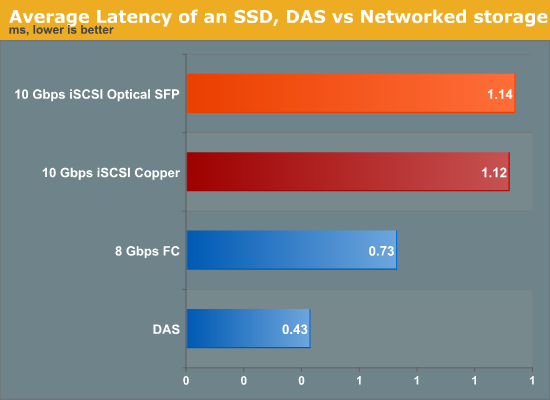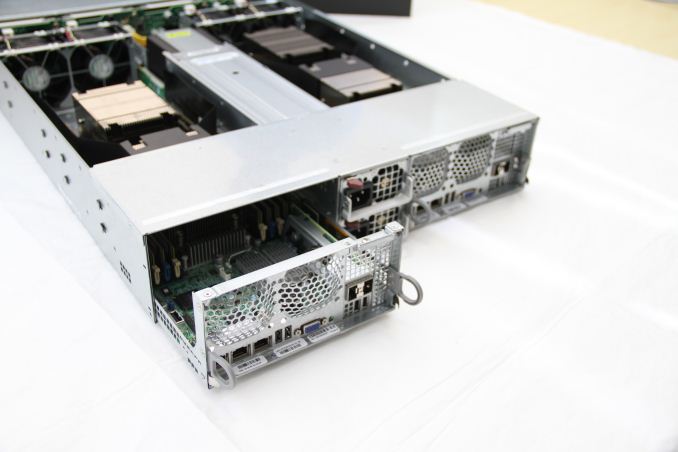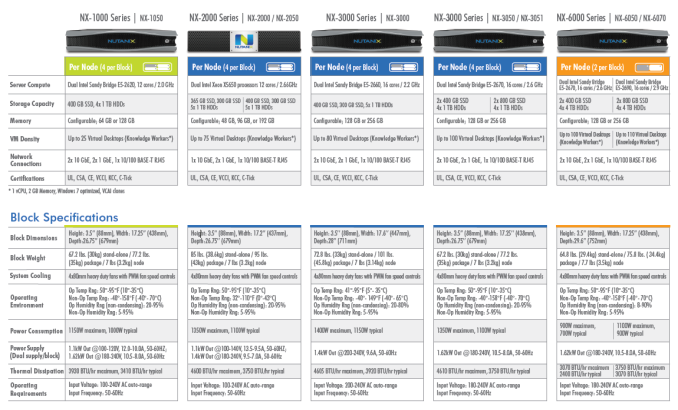The Impact of Disruptive Technologies on the Professional Storage Market
by Johan De Gelas on August 5, 2013 9:00 AM EST- Posted in
- IT Computing
- SSDs
- Enterprise
- Enterprise SSDs
Nutanix: No More SAN
It is not a secret that even though a SAN comes with all the virtues of centralized data, network storage comes with a network bandwidth and latency penalty. By simply attaching a flash array directly to a system (DAS), we can measure the extra latency compared to SAN (Storage Area Network). It amounts to between 0.3 and 0.8 ms depending on whether you use Fibre Channel or iSCSI over copper wires.

So the minimal latency was 50% to 100% higher in a lightly loaded SAN than when the same SSD was running inside the server. However, this was the minimal latency. This can quickly grow to several milliseconds when the network load goes up.
Nutanix believes that virtualized servers should use local storage, clustered together in a virtual storage pool. Each of the virtual machines connects to a storage VM. That storage VM is typically an iSCSI target inside a VM, also called a VSA or Virtual Storage Appliance. The VSA on each server node are clustered together by the Nutanix Distributed File System (NDFS). NDFS makes sure that if one node dies, the other nodes are still able to access the necessary files to run.
The VSA also leverages the latest flash technology. The most accessed data is on a Fusion-IO or Intel S3700 SSDs, depending on the Nutanix node model. The “colder” (not frequently accessed) data is automatically transferred to the SATA terabyte disks. It's basically another level of caching, only with larger data caches than we see in the desktop world.
Using what seems to be a Supermicro Twin or Twin² chassis, even an entry level four node Nutanxi NX-3050 should support up to 400 virtual desktops with a power consumption of about 1.1 KW. Compare this with your typical SAN array that typically needs 700W just for one midrange array, and you probably need several expansion modules before you can even think about supporting 400 virtual desktops.
Unfortunately, we cannot verify the claims of Nutanix right now, but our experience tells us that from a power and performance point of view it will be very hard for the typical "server plus SAN infrastructure" to beat the much simpler “integrate everything inside a dense server” platform. The only disadvantage is that the number of DIMM slots inside such server nodes is limited. That is why even the largest Nutanix hosts do not support more than 256GB per node, which might be a limitation in some virtualization environments.
Starting at $22000 per node, the Nutanix nodes are hardly cheap, but since you don’t need a SAN the total investment is a lot lower than the traditional approach, especially for virtual desktops. Nutanix seems to have convinced quite a few people as it claims it is the fastest growing IT infrastructure startup ever, with an $80 million annual run rate. Now they just need to prove they have the reliability and support infrastructure to win over additional customers.


_575px.jpg)










60 Comments
View All Comments
prime2515103 - Wednesday, August 7, 2013 - link
I know, it just seems unprofessional. It's a tech article, not a chat room.FunBunny2 - Tuesday, August 6, 2013 - link
What is always missing from such essays (and this one reads more like a 'Seeking Alpha' pump piece) is a discussion of datastore structure. If you want speed and fewer bytes and your data isn't just videos, then an industrial strength RDBMS with a Organic Normal Form™ schema gets rid of the duplicate bytes. Too bad.DukeN - Tuesday, August 6, 2013 - link
But has there actually been any disruptions to the top dogs?EMC, NetApp, storage from HP/Dell/IBM, Hitachi all have had significant earnings increases yet again.
So maybe a couple of new startups as well as FusionIO are making money now, but some of the big guys can probably just buy them out and shelf them.
davegraham - Tuesday, August 6, 2013 - link
Look at EMC's acquisition of XtremeI/O...that's a viable competitor that EMC has already been able to integrate as a mainstream product. Oh, and they're also using Virident PCIe cards for server-side flash. ;)DukeN - Wednesday, August 7, 2013 - link
But is that really disruptive, or business as usual? These guys usually buy up smaller technologies as needed and integrate them if needed. Most of their core business (spinning disks) has remained the same.bitpushr - Friday, August 9, 2013 - link
XtremIO is still not a shipping product. It is not generally-available. So, I do not think this qualifies as "integrate as a mainstream product".Likewise their server-side Flash sales (Project Lightning) have been extremely slow.
phoenix_rizzen - Tuesday, August 6, 2013 - link
If you ditch Windows on the desktop, you can do a lot more for a lot less.$22,000 for a Nutanix node to support a handful of virtual desktops? And you still need the VDI client systems on top of that? Pffft, for $3000 CDN we can support 200-odd diskless Linux workstations (diskless meaning they boot off the network, mount all their filesystems via NFS, and run all programs on the local system using local CPU, local RAM, local GPU, local sound, etc). The individual desktops are all under $200 (AMD Athlon-II X3 and X4, 2 GB of RAM, onboard everything; CPU fan is the only moving part) and treated like appliances (when one has issues, just swap it out for a spare).
No licensing fees for the OS, no licensing fees for 90+% of the software in use, no exorbitant markup on the hardware. And all staff and students are happy with the system. We've been running this setup in the local school district for just shy of 10 years now. Beats any thin-client/VDI setup, that's for sure.
turb0chrg - Tuesday, August 6, 2013 - link
Another vendor doing hybrid storage is Nimble Storage (http://www.nimblestorage.com/). I've looked at their solution and it is quite impressive. It's not cheap though.They also claim to be the fastest growing storage vendor!
dilidolo - Tuesday, August 6, 2013 - link
I have 2 of them for VDI, they work fine, but I wouldn't call it enterprise storage.equals42 - Saturday, August 17, 2013 - link
It's only iSCSI so you better like that protocol.